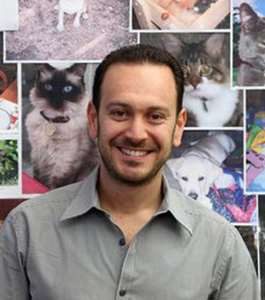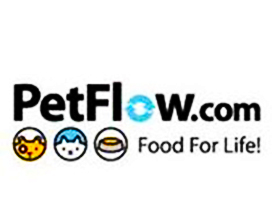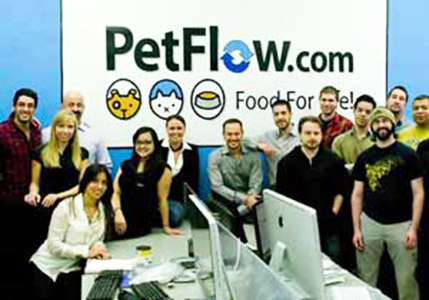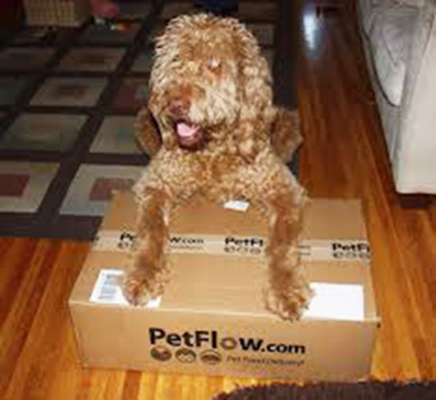- Hear About The PE Deal Behind Azoogle From Alex Zhardanovsky
- How Did The Azoogle Guys Use Leadgen Concepts To Test Their New Business?
- Learn About The Leadgen Guys Building A Petfood Company
Full Interview Audio

Personal Info
Sports Teams:Toronto Maple Leaves
Favourite Books:
- Entrepreneurship by Robert Hisrich (Author), Michael Peters (Author), Dean Shepherd (Author)
Most Influenced By:His Father
Twitter: http://twitter.com/alexzhard
Personal Blog: http://facebook.com/zhard
Website: http://petflow.com
Interview Highlights
This is a condensed, lightly edited transcript of an audio interview. The full audio is available and highly recommended. The interviewee may post clarifications in the comments.
Adrian Bye: Today I’m here with Alex from PetFlow. Alex has a fairly illustrious history starting at Azoogle and has done a lot of different things. He is doing a pet food business and I’ve read a little bit about it and I think the reasons he is doing it are really interesting.
So Alex, sorry to take over your introduction, but maybe if you can start off and tell us a little bit about yourself?
Alex Zhardanovsky: Well, I founded a company called AzoogleAds which was a very popular performance based network. That business grew tremendously from the time that we started in 2002 until 2005, at which point we sold a big piece of the company to a private equity firm. I stuck around for 5 years after that with my co-founder, Joe Speiser, at which point we started looking at new and interesting ideas. We had a whiteboard of those new and interesting ideas and it just so happened, that at that time, my girlfriend called me and she said “you’re out of dog food!” I said “well, you’re out of dog food” and she said “no, YOU”RE out of dog food.” So I had to run to a corner store to get food for my dog, and of course, the store didn’t have it and it was 7 o’clock and every other store was closed, so I did not feed my dog that night.
That was a problem and I wished there was a place where I could go and just order this food online. When I went online to try and find it, there was a site that was willing to sell it to me. They were selling it for cheaper than the local store did, however, I had to pay a $15.00 shipping fee to get it delivered to my house, which seemed astronomical to me.
So I tried to find other stores where I could do the same thing, and again, there was a huge shipping fee where they didn’t even have the product. So I said there’s something here. Let’s see if people would be open to signing up to have regular scheduled deliveries of their pet’s favorite food delivered to their home. So we put up a simple landing page and tested whether it would make sense for people to sign up. We had an overwhelming response to that and said, we’re on to something, let’s build it.
That was 2 years ago, and so where we are today, is that we own PetFlow.com, which has been growing phenomenally well and ‘knock on wood’ is now our new baby.
Adrian Bye: So it’s interesting, you built Azoogle into a pretty cool business. I didn’t hear of many other networks going the private equity route like you did and that’s pretty interesting to me. Can you talk about some of the numbers behind that, and how you felt about that in hindsight?
Alex Zhardanovsky: Well look, hindsight is a difficult thing. Joe and I thankfully, knock on wood, have done very well. In hindsight, we probably could have done better if we had just maintained control of the company and maybe sold for a bigger number.
Adrian Bye: So we are a lot of years after this all happened now. Can you share some of the specifics in terms of the numbers?
Alex Zhardanovsky: It’s public knowledge. It was $48 million that we got, and revenue of the company at that point was about $64 million. We projected $48 million, so we probably got a little less than we should have and the following year we did just about $100 million and the company kept growing after that.
Adrian Bye: Now it’s interesting that you guys have taken a turn, you are not heading back into the ad:tech space, you’re going more into a startup and raising money. Why the change?
Alex Zhardanovsky: When we got into this we wanted to control something end to end. The days of Azoogle, or even just anybody who is in the ad:tech space, you’re really relying on a whole lot of other people to make your business tick, and to make your business work, and to make sure that you are able to pay your bills. If an advertiser doesn’t pay, you’re screwed. If a publisher does something wrong, you’re screwed.
Here, my box arrives at a customer’s home, has our logo, has the words PetFlow.com very clearly marked on that box. When a person opens that box, they’re taking the food that’s in that box and feeding it to what they consider their children. So it’s a very rewarding and different experience running this company, or even any company, where you are selling a physical good and you’ve got real customers.
In the Azoogle days, we were relying on both our advertisers and our publishers to make sure we stayed in business and that’s not what we wanted to do here.
Adrian Bye: I want to get into the specifics of how you tested the original idea for PetFlow, but how many other ideas got to that stage where you actually made a landing page and did some tests?
Alex Zhardanovsky: You know, this was THE one. When I had a hard time finding what I needed online, I said there’s a reason why that’s happening. That reason was that this industry has kind of been devoid of investment for the last decade and so, when we kind of landed on this one, a light went off and said, “ok, we’re on to something, let’s start building.”
Adrian Bye: Can you walk us through the test. Was it one landing page? What was the sequence of pages?
Alex Zhardanovsky: Yeah, we put together one landing page at the beginning. It was pretty direct about the fact that you were signing up for some sort of an auto-ship platform. We did a Facebook test, threw some flyer traffic at it, and I think we had at least a 10% conversion rate, which was pretty high, considering most of the Leadgen is in a 3-5% range.
So we saw a pretty good response rate to the lead form and obviously, what the thank you page said was “thank you, we’re not ready yet we’ll let you know when we are.” So we actually had angry customers, well potential customers, emailing us saying “where the hell is the damn dog food?” That happened in December of 2009 and it took us until July 2010 to actually have a working site for people to be able to order from. When I say ‘working’, I use that word very kindly!
Adrian Bye: So your initial test then was a Leadgen. How many fields on the Leadgen was it?
Alex Zhardanovsky: It was First, Last, City, State, Zip – we wanted to make it involved enough so that we weren’t just getting, I’m John Smith give me dog food! It was full postal, I don’t think we had any dropdowns for what type of food or what kind of dog you had, it was just to see if people would be open. It wasn’t so much that we wanted to get people’s data, because we knew we weren’t going to be selling them anything for the first little while. It was just to see if people would go through all the hoops of actually giving us their data if they were actually interested. 
Adrian Bye: Was it one page as a Leadgen or was it multiple?
Alex Zhardanovsky: Yes, it was just a one pager.
Adrian Bye: What you wanted to know is could you sell it to the mass market and would it convert?
Alex Zhardanovsky: Exactly. I think it was maybe $1,000 that we spent.
Adrian Bye: I mean, that’s huge. Because if that had bombed, maybe you would have tried some other creatives until you found something that worked, but if it was really just looking bad, you would have known that after a few thousand dollars and you would have been done.
Alex Zhardanovsky: Absolutely, yes. It was that test that led us to investing millions of dollars of our own personal money into starting this company.
Adrian Bye: So tell us then, after you’ve got your test, what was the next stage of turning that into a business?
Alex Zhardanovsky: We were initially going to partner with somebody who was already in the space. Unfortunately, that didn’t work out because you really have to own one of these things end-to-end. We realized that if we leave the warehousing to somebody else, if we leave the product sourcing to somebody else, we’re still going to be at the mercy of somebody else controlling our destiny.
So it took us until March, to be able to actually have a site. There might be great off-the-shelf software, but they did not fit the vision that we had for the company. Our interfaces and our site is very different than most other sites. We kind of built it for the way that we like to shop online. The ‘proceed to checkout’ button is one of the biggest things on the site. You can add items to your cart without going and looking at a description of those items because many people don’t want to look at them. So you can purchase from our site in much fewer clicks than you would from other people.
Adrian Bye: You’ve designed the site around conversions?
Alex Zhardanovsky: Yes, correct. That’s the world that I come from, maximizing conversions. In March of 2010 we had the site ready, so we hired our first employee who was charged with sourcing products and maintaining supplier relationships.
Adrian Bye: How do you optimize a site like this?
Alex Zhardanovsky: We are constantly iterating and constantly changing the site to test and see if we can get better and better conversion on an ongoing basis, so things are changing. They’re not major things, they’re small things that change from time to time, all the time.
Adrian Bye: Yeah, and I think you should take this as a compliment, but I think it’s an ugly site, but I imagine that it converts really well?
Alex Zhardanovsky: Yes it does. We’ve seen our conversion rate continue to increase from the day that we launched. We’ve had partners of ours test our site against others and they continuously tell us that ours out-performs, so we’re doing something right.
Adrian Bye: So you’ve built this on a platform that enables you to split test a shopping site. That’s kind of interesting. I could imagine that most shopping sites would not be able to be particularly designed to be able to be split tested like this?
Alex Zhardanovsky: Yes, like I said, we test small elements, small changes make for big differences in conversions. They don’t have to be monumental changes on your site in order to see if you can get an increase in conversion.
Adrian Bye: It’s just very well optimized. I’ve done a lot of split testing and it’s great, it’s responsive, you’ve got testimonials on there. So how about the business model? To me I thought it was amusing and that people would laugh at you, because I know that you guys are building this around metrics, but how do the metrics actually back out?
Alex Zhardanovsky: The metrics do back out. The difference between us and Pets.com is a big one. If you look at any of their advertising, most of their ads were centered around a Frisbee, a toy, the tennis ball, the dog bowl or a bed, basically non-consumables that the customers really did not need. They were nice to have, but if I bought a dog bed yesterday, I really don’t need you to give me discounts on another dog bed for the next 10 years.
We started the business in a completely different way. We are selling you products that you have to have. So, because of the fundamental difference in the business model, our customers HAVE to have the product that we are selling them. So what we see is about 50% of our new customers sign up for auto ship on their very first purchase. The other 50% make a one-time purchase and then they usually come back to the site and make subsequent purchases on an as-needed basis. Again, these are products that they HAVE to have.
Adrian Bye: So you mentioned 50% of your customers go straight into continuity?
Alex Zhardanovsky: Yes.
Adrian Bye: Do you have retention numbers?
Alex Zhardanovsky: Yeah, there are no specific numbers that I can share, those are a little private. But you know, if someone bought a bag of Orijen Regional Red for $87.99 it’s because it’s a product that they are feeding their pet and when that food runs out, they don’t simply buy something else, they need another bag of Orijen Regional Red. What I always say is it’s up to us to lose that customer.
Adrian Bye: So then when you’ve got that relationship, you can build in up-sells etc?
Alex Zhardanovsky: Absolutely. That’s the traditional story. You start with the consumables, you start with the essentials. It’s the same thing that Diapers.com did, except they started with diapers, which had a much lower gross margin than pet food does. So eventually, they were able to get those customers to purchase many additional products from them. We are starting to see success in that area as well.
Adrian Bye: How are you acquiring leads? Are you buying traffic?
Alex Zhardanovsky: They’re everywhere. We do a tremendous amount on Facebook. If you go to https://www.facebook.com/pages/PetFlow/102031069885788 you’ll see some of what we do. We get a lot of customers from Facebook. I just did an interview yesterday about our Facebook strategy and it’s working well for us. You know Google, of course, we buy some display, we do a lot offline as well, so it’s the full boat. We get traffic everywhere.
Adrian Bye: So what you are doing is working across mass media?
Alex Zhardanovsky: It’s the pitch that I used to give to advertisers, that you can’t just look at the one channel on its own, you have to look at them all holistically. We look at everything in aggregate. We try to match media spend in a particular market with search traffic in that market.
It’s all those things together. We measure our bottom line CPA. Are we willing to acquire our average customer at this CPA given the metrics that our business generates? So far that answer has been yes.
Adrian Bye: So the areas you can optimize on – you can optimize on the site, you can optimize on your fulfillment and then you can optimize on the cost of your supplies – those can be the ones you can really optimize on and then if you do a good job with those, you get better profit?
Alex Zhardanovsky: Right, and on top of that, we take possession of all of our products. So if we wanted to launch 4,000 new SKUs, we have to buy in those 4,000 new SKUs to bring them into our warehouse. The nice thing is, the more SKUs we add, and it’s kind of like one of those “duh” moments, the more SKUs we have, the more sales we get because we have more products to be able to sell to our customers.
Adrian Bye: Cool. Was there anything you want to talk about that we didn’t cover?
Alex Zhardanovsky: No, I think we’ve covered this one in depth. If anybody is starting their own business, they should love what they are doing. It was a difficult decision not to go into the professional career, but I think it was the best decision that I ever made. So it’s been pretty awesome and thankfully that’s gotten me to where I am today. When we were talking about hindsight and having sold to private equity, you can’t look back you only have to look forward. If you question all of your decisions, you’ll never make another one. That’s kind of how I look at things.
Adrian Bye: Well fair enough! Thank you very much for doing the interview.
Alex Zhardanovsky: My pleasure.









